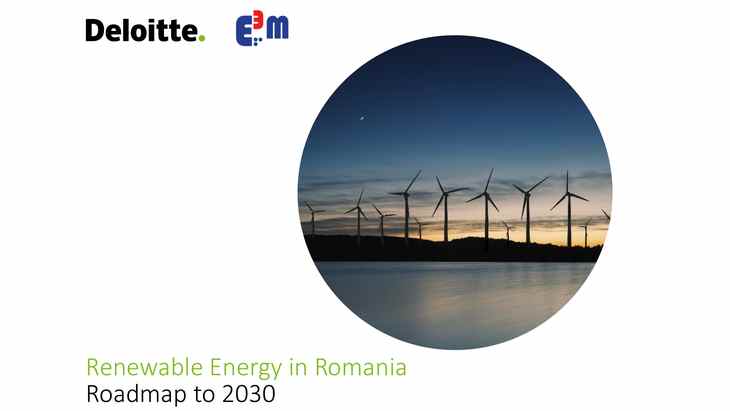Romania’s renewables industry presented on Friday the updated form RES Roadmap to 2030, a study conducted by Deloitte at the request of RWEA and RPIA. The document provides projections for 2030 based on the current trajectory assumed by Romania, as well as a modelling of the targets necessary for Romania to comply with the obligations of the REPowerEU plan. In particular, the document highlights the gap that Romania will need to close in order to reach the EU’s REPowerEU targets, namely a 45% share for renewable energy sources at EU level.
The study was conducted using the same tool used by the European Commission – E3 Modelling – in developing Fit for 55 projections and proposes two scenarios: 1. “As-is”, with projections based on implemented policies and measures and 2. “REPowerEU scenario”, a top-down approach in order to achieve the REPowerEU targets at national level in Romania.
In both scenarios, electricity demand is set to increase, in line with projected economic context, but the advance should be much stronger – 60% in 2030 compared to 2020 – based on a steady electrification process. The difference is made up by electricity consumption for the production of Renewable Fuels of Non-Biological Origins (RFNBOs) for transport. This will require an additional 10 TWh over and above the existing scenario, the Deloitte analysis points out.
In both scenarios, the increasing demand for electricity will be covered mainly by investing in RES and natural gas new capacity, which implies an increase in the relative share of wind, solar and gas-fired power. In the REPowerEU scenario, Romania could become a net exporter of electricity again, while in the current scenario Romania will continue to depend on electricity imports to cover domestic demand.
In both scenarios, new investments in CCGT units are expected to increase the weighted utilization rate of gas-fired power plants, paired with the Black Sea extraction of natural gas. Coal capacity decreases by 76% and 85% (in the REPowerEU scenario) between 2020 and 2030. The coal phase-out requires additional natural gas to meet the demand for heat/steam. No additional nuclear capacity is expected to be commissioned by 2030 (with the exception of the modernization of reactor 1).
What is different is the additional need for wind (an extra volume of over 7 GW) and PV (an extra volume of over 6 GW) generation capacity in the REPowerEU scenario.
The biggest difference, according to Deloitte’s analysis, is in storage capacity and energy demand for hydrogen production (P2H) and synthetic fuels (P2x). In the REPowerEU scenario, “battery storage becomes essential for grid balancing”, electrolyzers produce hydrogen for various uses, and “final energy demand in transport is mainly composed of hydrogen (10%) and clean hydrocarbons (i.e. synthetic gasoline, kerosene and fuel oil produced from electricity)”.
As a result, the total share of renewables in the REPowerEU scenario should, according to Deloitte, be 44% in 2030, namely 66.9% in electricity generation (compared to 51.7% in the current scenario), 47.3% for heating and cooling (compared to 33.5% in the current scenario) and 24.6% in transport (compared to 14.7% in the current scenario). Only in such a scenario could there be a significant reduction in carbon emissions, to 26% below 1990 levels. In the existing scenario, they would remain close to the 2020 level, at around 38% of the 1990 level.
In a page of recommendations, the authors of the study call for the urgent strengthening of inter-ministerial approaches and governance, allowing for the simultaneous and interrelated updating of various strategies on environment, transport, energy, etc. In particular, Sorin Elisei, leader of the energy and sustainability practice at Deloitte Romania, drew attention to the Green Deal requirements that 10% of land should be placed under strict protection. At the same time, Gilles Dickson, Executive Director of WindEurope, welcomed the EC policies whereby wind and solar projects have been declared of priority public interest and deadlines of up to 2 years have been imposed for complete permitting of these categories of projects. He urged the Romanian authorities to resist the temptation to “mess up the energy system through support schemes” introduced with the announced aim of protecting the population and industry.
